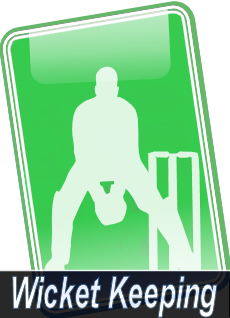How standing up to seamers will win you more games
Have you noticed how much more top wicketkeepers are standing up to seamers recently? It's a useful skill because it will get you more dismissals than standing back. This is especially true at club level where the pace of bowling is slower and the wickets are not as quick. You just need to be sure it is being done right.
When to stand up and when to stand back
Standing up is generally the best option at club level.
- Extra pressure on the batsman increasing the chance of a mistake
- Keeps the batsman in his crease reducing his scoring options
- Acts as an extra close fielder stopping tip and run tactics
- Adds the option of a stumping
- Increases bowler accuracy
This is not always the case so the keeper, bowler and captain will need to decide is when standing up is a good idea. These are the factors involved:
- Pace. The most obvious judgement is pace. Some bowlers are just too quick to attempt standing up. This is very rare below first class level so is not much of a consideration for most keepers. It's also worth noting that it may be pointless to try standing back to bowlers at the slower end of the spectrum. The keeper is slow close to these bowlers that there is hardly any time to react to edges anyway.
- Accuracy. At club level, accuracy of the bowler is more important than pace. Pitches are less true making leg side takes to seamers more difficult and there is an increase in the chance of byes getting through. If the bowling is poor, it's usually a better bet to stand back. If the bowler is that bad he won't be on for long.
- Swing/seam. Generally, the more the ball is moving, especially away from the bat, the better it is to stand back. Also remember that standing up to the swinging ball can pressure the batsman into a mistake so use your judgement.
- Batsman. Speaking of batsman, this is probably the major factor in deciding to stand up. A batsman who comes out of his crease can be restricted by standing up. Even if he is not doing this you can change his whole approach just by making him feel cramped. The match situation is important here too as you are balancing the risk of extra byes with the positive of pressuring a mistake.
- Confidence. As a keeper you need to believe you have the ability to stand up to the quicker bowlers. Wearing a helmet can help, and practice is vital. It's also a good idea to have some self-talk tactics to keep your self confidence high and recover from mistakes (not even Alan Knott was perfect).
- Bowler. Finally you need to know if the bowler can deal with you standing up. Some bowlers don't like it for pride reasons, some get more accurate while others lose their accuracy. I find bowlers with a natural length that is a bit shorter struggle more with the keeper up. This seems to be because the natural inclination is to pitch the ball up more. This means you should always consult with the bowler before using the tactic and defer to his decision if he wants you to stay back.
The art of standing up
The ability to stand up comes with practice, so do it as much as you can in as realistic a situation as possible. I'm always pushing my club to play mini practice games rather than net. It give me a chance to keep and is more realistic for bowlers and batsmen.
The technique itself is not really any different to standing up to a spinner, just performed more quickly. Soft hands and excellent judgement are still vital, as is keeping your head, hands and feet in line with the ball. Moving down the leg side is still a matter of seeing the pitch of the ball then moving quickly. Your judgement of the ball, foot and hand speed needs to be excellent as you will be blinded by the batsman. Even then you will still not take everything cleanly as the ball is more likely to do something unexpected than on better pitches. You still need to think about catching the ball before you think about the stumping.
Standing up is often about pride so have the courage to back off if things are not going your way to a particular bowler. Above all, you must believe in your ability to do it. The more you try the better you will get and the more confidence the bowlers will have in you to pull off that leg side stumping or wide catch. Once you are in that position, you know you will be helping the team to win more games.
Want to know the secrets of how to change a game with a moment of wicket-keeping brilliance? Pick up a copy of "Wicket-Keeping: The Ultimate Guide to Mastering the Art" and become a better keeper today.
- Login to post comments



Comments
I think the most important factor that you missed out is the LBW.
A batsmen who HAS to bat in his crease is much more exposed to an LBW decision than if he were able to bat 1 yard outside his crease.
Great point Adam, hopefully you will also be restricting his footwork to add to that.